Paul Klee Biography
Paul Klee was born on 18 December 1879 near Bern in Switzerland into the family of Hans Klee, a music teacher, and his wife Maria Frick, also a musician. As a boy Paul learned to play violin. As well as his training in music, he received a thorough classical education in the Literarschule in Bern. Ancient Greek, modern French, classic and contemporary French and German art, and literature were his favorites. Klee graduated from the school in 1898. Through his later schooldays he hesitated between music and art for a career, finally choosing art and the Munich Academy, where he would study it.
Klee arrived in Munich in October 1898 and at first studied privately. The next year he entered the Academy, where he spent 2 years. Feeling unsatisfied with his academic education, Klee left the Academy and traveled in Italy from October 1901 to May 1902. His early work was almost exclusively pen-and-ink drawings and etchings, many of them satirical. He showed his work in different exhibitions and joined a Swiss graphic artists' society. In 1905 he made his first visit to Paris.
In 1906, Klee married the pianist Lily Stumpf and they settled in Munich, then an important center of avant-garde art. In 1910-11 Klee had his first major exhibitions in the 3 cities of Switzerland: Bern, Zurich, and Basel. In 1912, he contributed 17 graphic works to the second exhibition of Der Blaue Reiter (The Blue Rider), the avant-garde artistic society founded by W. Kandinsky and Franz Marc. That same year Klee visited Robert Delaunay in Paris. The latter’s influence on Klee’s development is considered the strongest outside his immediate circle of avant-garde Munich painters. Klee’s translation of Delaunay's essay "On Light" appeared in the Sturm in January 1913.
In April 1914 he and fellow painters Macke and Louis Molliet visited Tunisia. However, he interrupted the voyage abruptly and returned home, feeling that he had “suddenly grasped the idea of light and was a painter now”.
During the First World War, Klee was not immediately conscripted, but in March 1916 he was called up for infantry training and then attached to an air force unit where he repaired damaged aircraft, painting their numbers and insignia. Though Klee had few opportunities for artistic work, he managed to do some painting on aircraft canvas. In 1918 he returned to Munich. The avant-garde circle in Munich had been dispersed - Macke and Franz Marc had been killed while Kandinsky had returned to Russia. Klee stayed in Munich alone and continued to develop his ideas.
In November 1920 Klee was invited to teach at the Bauhaus at Weimar, where his friend W. Kandinsky would also become a faculty member in 1922. Bauhaus was an innovative school aiming at uniting fine and applied arts and architecture in a new manner suitable for an industrial age. Klee’s teaching included lecturing with demonstrations on form and color in relation to nature and also supervising bookbinding, metal and weaving workshops. Klee’s Pedagogical Sketchbook, one of his essays on art theory, was published in Bauhaus in 1925. In the essay Klee defined and analyzed the primary visual elements and the ways in which they could be applied. In April 1931, two years before the Bauhaus was closed by the Nazis, Klee resigned to take up a professorship at the Düsseldorf Academy of Fine Arts. He held the post for only two years before the Nazi campaign against modern artists brought about his dismissal. In 1933, Klee left Germany to return to Switzerland.
In the summer of 1935 the symptoms of his fatal illness (later diagnosed as sclerodermia) appeared. But he remained productive to the end, which came in June 1940.
Most art critics highly appreciate Klee’s contribution to the development of art in the 20th century. He was extremely inventive, bravely experimented with styles and materials, and the visual effects they gave, ignoring rules and fashion.
“The work of Paul Klee, of all periods but especially the last, has been of enormous importance in the development of modern art. Its effect was delayed by Fascism in Germany and perhaps by a lack of acceptance in France, but since the Second World War it has been constantly increasing, Klee had at his command a greater variety of formal invention than any other modern master. Almost alone he never succumbed to pressure to repeat himself or to the forces that make for decline in famous artists. His whole late work was a manifesto and act of bravery, for it was far less easily acceptable than what had gone before. Above all it is by his intellectual capacity that Klee dominates his contemporaries, none of whom, not even Kandinsky, could think through the full implications of what they were doing as he could. Many talked about a new relationship between art and nature; only Klee actually tried to define it, and with considerable success. At a time of uncertainty and loss of direction in art he is a source of confidence and admiration.” (Klee by Douglas Hall. 1977. Phaidon)
Bibliography
Paul Klee: Selected by Genius, 1917-33 by Roland Doschka, Ernst-Gerhard Guse, Christian Rumelin, Victoria Salley, Stadthalle Balingen. Prestel Publishing, 2001.
The Paul Klee Catalogue Raisonne, Volume 9 (1940) by The Paul Klee Foundation. Thames & Hudson, 2004.
The Diaries of Paul Klee, 1898-1918 by Paul Klee, Felix Klee (editor). University of California Press, 1964.
Paul Klee: 1879-1940 (Basic Art) by Susanna Partsch. Taschen, 2000.
Paul Klee: Painting Music (Pegasus Library) by Hajo Duchting. Prestel, 1997.
Paul Klee: The Nature of Creation/Works 1914-1940 by Robert Kudielka, Bridget Riley. Lund Humphries Publishers, 2002.
Klee, Kandinsky, and the Thought of Their Time: A Critical Perspective by Mark Roskill. University of Illinois Press, 1995
Paul Klee by Jean-Louis Ferrier. Vilo International, 1999.
- On A Motif From Hamamet.
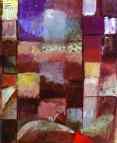
1914. Tempera on board. 27 x 22.5 cm. Kunstmuseum Basel, Basel, Switzerland.
- Hermitage.
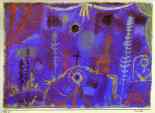
1918. Watercolor on chalk ground. 18.3 x 25.4 cm. Paul Klee Foundation, Kunstmuseum, Berne, Switzerland.
- Cosmic Composition.
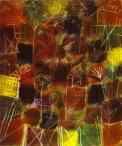
1919. Oil on pasteboard. 48 x 41 cm. Kunstsammlung Nordrhein-Westfalen, Düsseldorf, Germany.
- Nocturnal Festivity.
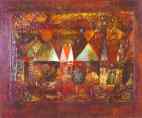
1921. Oil on board. 50 x 61 cm. The Solomon R. Guggebheim Museum, New York, NY, USA.
- A Young Lady's Adventure.
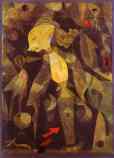
1921. Watercolor. 43.8 x 30.8 cm. Tate Gallery, London, UK.